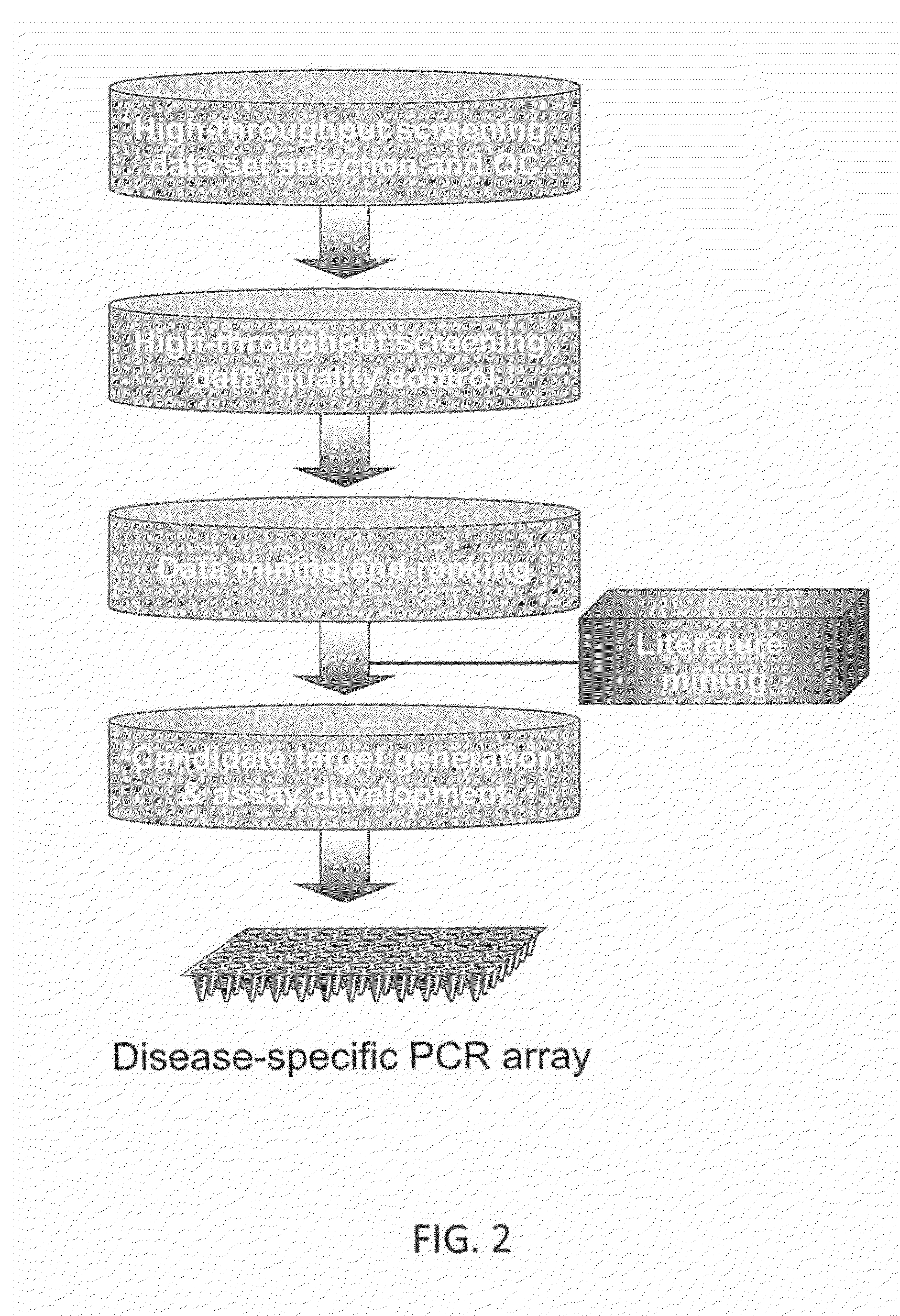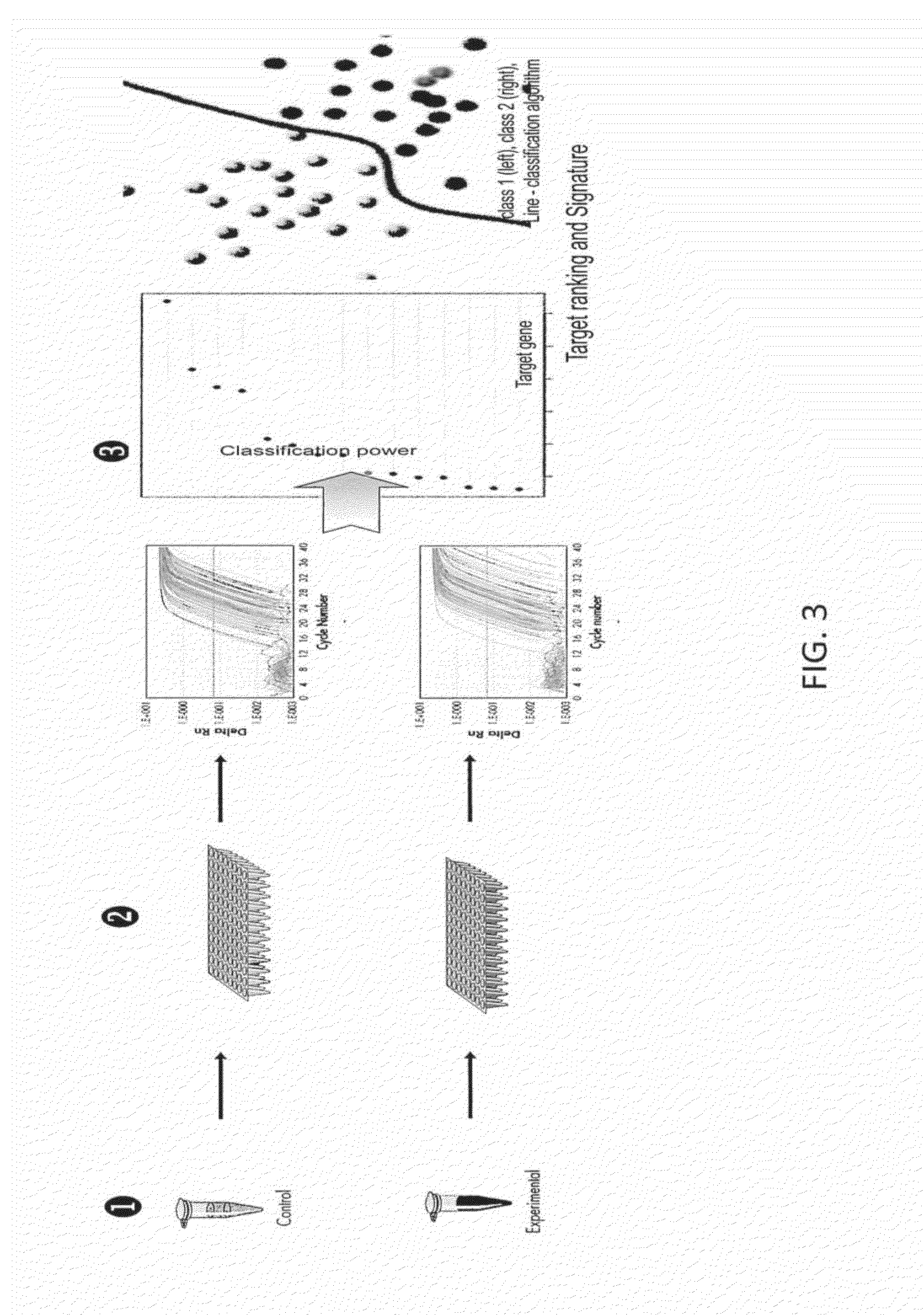Thyroid cancer biomarker
a biomarker and thyroid cancer technology, applied in the field of thyroid cancer biomarkers, can solve the problems of unneeded operations, difficult clinical classification of thyroid nodules, and difficulty in achieving clinical implementation in clinical settings
- Summary
- Abstract
- Description
- Claims
- Application Information
AI Technical Summary
Benefits of technology
Problems solved by technology
Method used
Image
Examples
example 1
qPCR Method
[0095]Total RNA was reverse transcribed to complementary DNA (cDNA) according to the manufacturer's protocol (Qiagen, QuantiTECT reverse transcription kit, Valencia, Calif.). SYBR Green Biomarker Custom PCR arrays was used for gene expression detection. All the primers were synthesized by Integrated DNA Technologies (IDT, Coralville, Iowa). A quality control procedure was followed to ensure specificity and efficiency with a serial dilution of reference universal genomic DNA and cDNA. Amplification specificity was confirmed by agarose gel electrophoresis of the PCR products. Customized 384-well primer plates were printed. For each sample, cDNA equal to 0.8 ng total RNA input was mixed with SYBR Green master mix (QuantiTECT SYBR Green PCR Kit, Qiagen) in a 10 micro litter reaction volume. qPCR amplification was done on ABI 7900HT Real-time PCR System. Amplification was carried out for 40 cycles (at 94° C. for 15 seconds, at 55° C. for 30 seconds, and at 72° C. for 30 second...
example 2
Thyroid Malignancy qPCR Array
[0096]The published literature was searched and published high-throughput screening (microarray) data from 51 benign and malignant thyroid samples were selected for study. Outlier samples were identified and are shown in FIG. 4A. Outlier samples were removed from the dataset because they impaired sample clustering as shown in FIG. 4B. Sample clustering improved with removal of the outliers as shown in FIG. 4C. Multiple mathematical models including RF, NSC and SVM were used for biomarker candidate selection, and genes selected based on the literature were added for better potential biomarker coverage. FIG. 4D shows the overlap of the top 100 genes across the three representative mathematical models. qPCR assays were then performed on the top-ranked targets and were optimized tor their sensitivity, specificity and efficiency. Target assays meeting the QC standards were used for thyroid malignancy qPCR array. Ten normalization reference gene candidates wer...
example 3
Additional Panel Development
[0100]A 20 reference gene panel was tested (data not shown) with 6 thyroid samples covering normal and different stage of thyroid tumor (OriGene, Rockville, Md.). The top 10 genes were selected based on their expression stability and variation between benign and cancer group. When the final qPCR results were collected with all thyroid samples, reference gene expression was further analyzed. The reference genes with the smallest difference between benign and malignant groups and highest expression stability were picked. Five genes were selected as reference genes; TBP, RPL13A, RPS13, HSP90AB1 and YWHAZ.
[0101]A repetitive gene selection and ranking process was then repeated with random forest (RF). Target genes were pre-filtered with their expression level and the relative expression: range difference. The genes with no or extremely low expression, as well as the gene that have limited difference (<0.5 ΔCt, easily to be reversed by qPCR variation), were rem...
PUM
 Login to View More
Login to View More Abstract
Description
Claims
Application Information
 Login to View More
Login to View More - R&D
- Intellectual Property
- Life Sciences
- Materials
- Tech Scout
- Unparalleled Data Quality
- Higher Quality Content
- 60% Fewer Hallucinations
Browse by: Latest US Patents, China's latest patents, Technical Efficacy Thesaurus, Application Domain, Technology Topic, Popular Technical Reports.
© 2025 PatSnap. All rights reserved.Legal|Privacy policy|Modern Slavery Act Transparency Statement|Sitemap|About US| Contact US: help@patsnap.com



